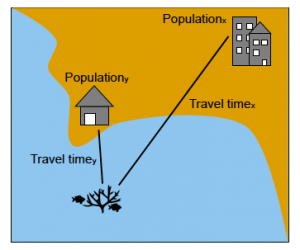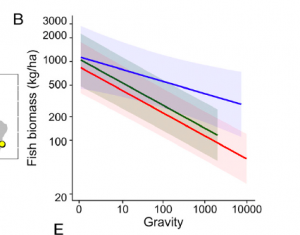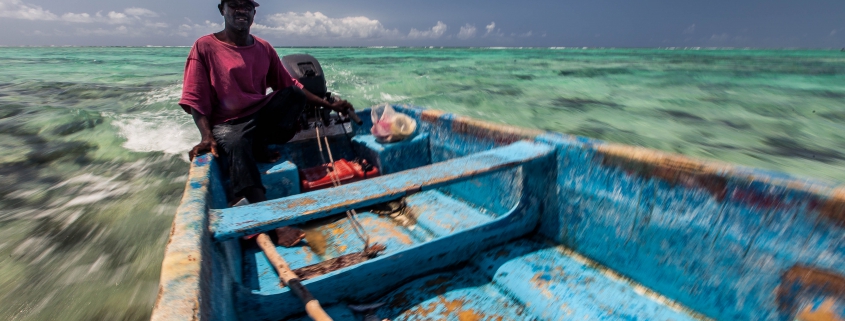Gravity of human impacts mediates coral reef conservation gains
By Brenna Bales, SRC intern
Communities around the world depend on coral reefs for their livelihood, for tourism, and for protection against coastal degradation. With an increasing human population comes increasing human impact on these coral reefs and a decrease in the ability of a reef to provide the benefits listed above. Direct human impacts include overfishing, polluting the reef with trash or chemicals, and dredging; however, there are indirect human impacts such as anthropogenic climate change. Greenhouse warming affects ocean temperature which can stress corals (Jokiel 2004), and ocean acidification from carbon uptake can decrease the ability of corals to build limestone foundations (Langdon et al, 2000).
In Cinner et al’s analysis, the magnitude of human impact on of 1,798 tropical reefs in 41 nations/states/territories was described and quantified. In order to quantify this impact, the authors used a social science metric termed “gravity”, which has been used from economics to geography. For the adaptation to an ecological analysis, the gravity of human impact was measured as a function of how large and how far away a population of humans was to a certain coral reef (Figure 1). In each location, the status of reef management ranged from openly fished (little to no management), to highly protected marine reserves where fishing is completely prohibited.

Figure 1. The authors’ interpretation of “gravity” as a function of the population of an area
divided by the time it takes to travel to the reefs squared. (Cinner et al, 2018)
Two expected “conservation gains” (differences in the progress of a coral reef ecosystem when protected versus unprotected) in all regions were analyzed as to how they are influenced by human activity. The first was targeted reef fish biomass (species usually caught in fisheries) and the second was the presence of top predators within the ecosystem. Conservation gains can be beneficial to both people and ecosystems; When the health of a protected coral reef improves, it might drive new recruits and help re-establish other nearby reefs that are fished more. The authors hypothesized that the target conservation gains would decline with increasing gravity in areas where fishing was allowed, but that marine reserves would be less susceptible to these gravity influences.
Analysis of visual fish count data collected from 2004-2013 showed that gravity strongly predicted the outcomes for fish biomass in a reef ecosystem. Biomass in marine reserves showed a less steep decline with increasing impact as compared to openly fished and restricted areas (Figure 2). This was due to an unforeseen relationship between gravity and the age of a marine reserve. In high-gravity areas, older reserves contributed more to fish biomass when compared to low-gravity areas. These older reserves have had more time to recover after periods of high fishing stress. Even in the highest-gravity reserves, fish biomass was about 5 times higher than in openly fished areas. Top predators were only encountered in 28% of the reef sites, and as gravity increased, the chance of encountering a top predator dropped to almost zero. Overall, highly regulated marine reserves in low-gravity situations showed the highest biomass levels, and the greatest chance of encountering a top predator.

Figure 2. Modeled relationships showing reef fish biomass declines with gravity increases by
regulation type. Openly fished (red), restricted (green), and high-compliance marine reserves
(blue). (Cinner et al, 2018)
Four explanations for the decrease of fish biomass and top predator encounters were (i) human impact in the surrounding area of a marine reserve affecting the interior, (ii) poaching effects, (iii) life history traits of top predators making them susceptible to even minimal fishing stress, and (iv) high-gravity reserves being too young or too small for drastic improvement. The fourth explanation was further analyzed, where large versus small reserves were compared. Not surprisingly, larger reserves had higher biomass levels and top predator encounter probabilities. Lastly, the ages of the reserves were examined. The average reserve age was 15.5 years compared to older reserves (29 +/- years), and older reserves had a 66% predicted increase in biomass levels. Analysis of the likelihood of encountering a top predator was less definitive, suggesting high-density areas, no matter the age, reduce this probability greatly.
Ecological trade-offs such as high-gravity reserves being beneficial for conservation gains like reef fish biomass, but not so much for top predators, are important to consider. Top predators can face more fishing stress even in remote areas due to their high price in international markets, such as sharks for their fins, explaining the observed difference in low-gravity fished areas versus low-gravity marine reserves. Overall, when aiming to create an effective marine reserve or even regulations that aid in conservation gains, it is imperative to consider the gravity of human impact in the surrounding areas. How the impacts of gravity can be reduced is critical as populations grow along coastlines and climate change stressors increase as well. Multiple forms of management will most likely provide the most benefit to stakeholders (Figure 3) and the ecosystem.

Figure 3. A fisherman in the town of Paje, Tanzania takes his boat out behind the reef barrier to
catch a meal. Stakeholders are an important part in considering reef management decisions, as
millions of people rely on the reefs for their meals just as this fisherman.
(https://commons.wikimedia.org/wiki/File:Fisherman_in_Paje.jpg)
Works Cited
Langdon, C., Takahashi, T., Sweeney, C., Chipman, D., Goddard, J., Marubini, F., Aceves, H., Barnett, H. and Atkinson, M.J., 2000. Effect of calcium carbonate saturation state on the calcification rate of an experimental coral reef. Global Biogeochemical Cycles, 14(2), pp.639-654.
Jokiel, P.L., 2004. Temperature stress and coral bleaching. In Coral health and disease (pp. 401-425). Springer, Berlin, Heidelberg.



